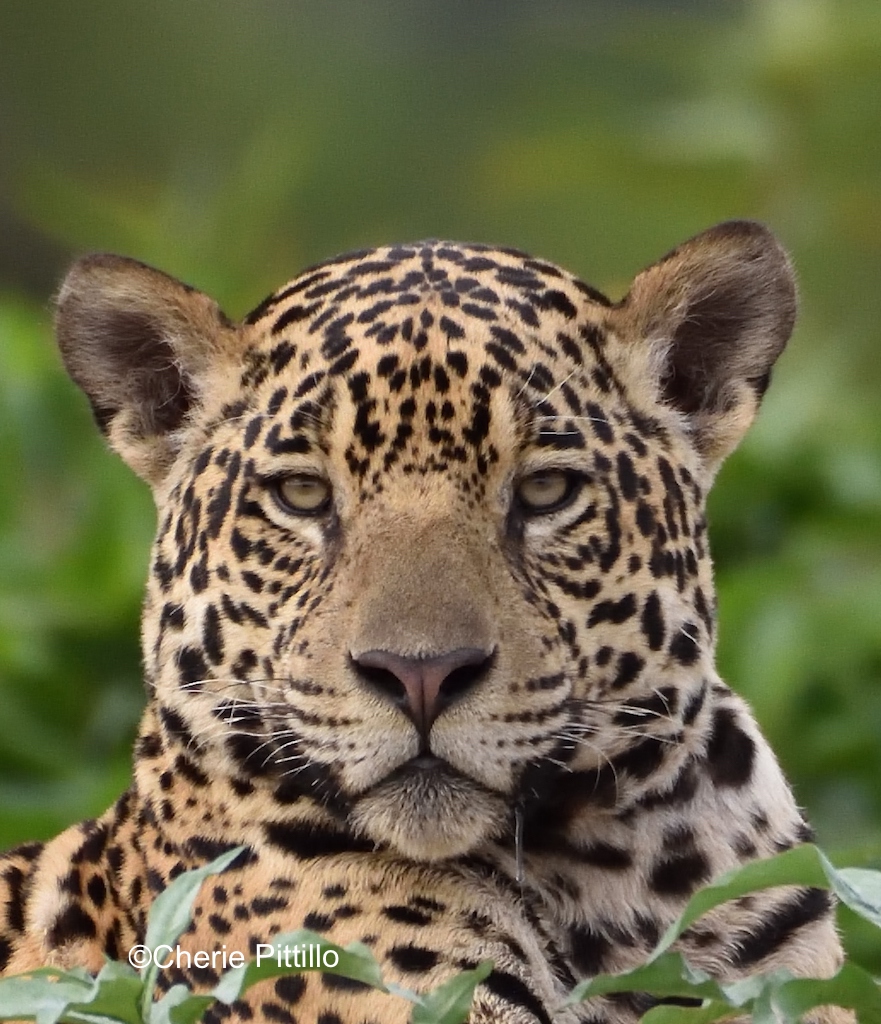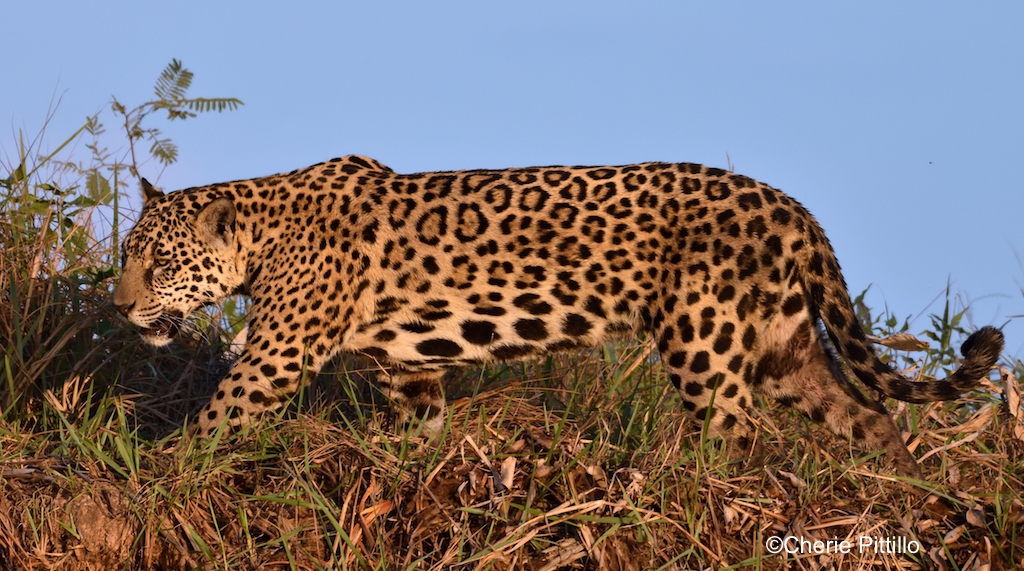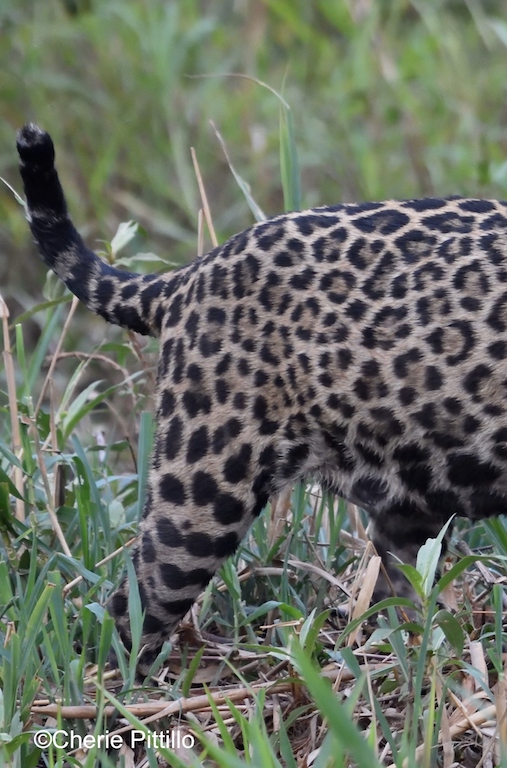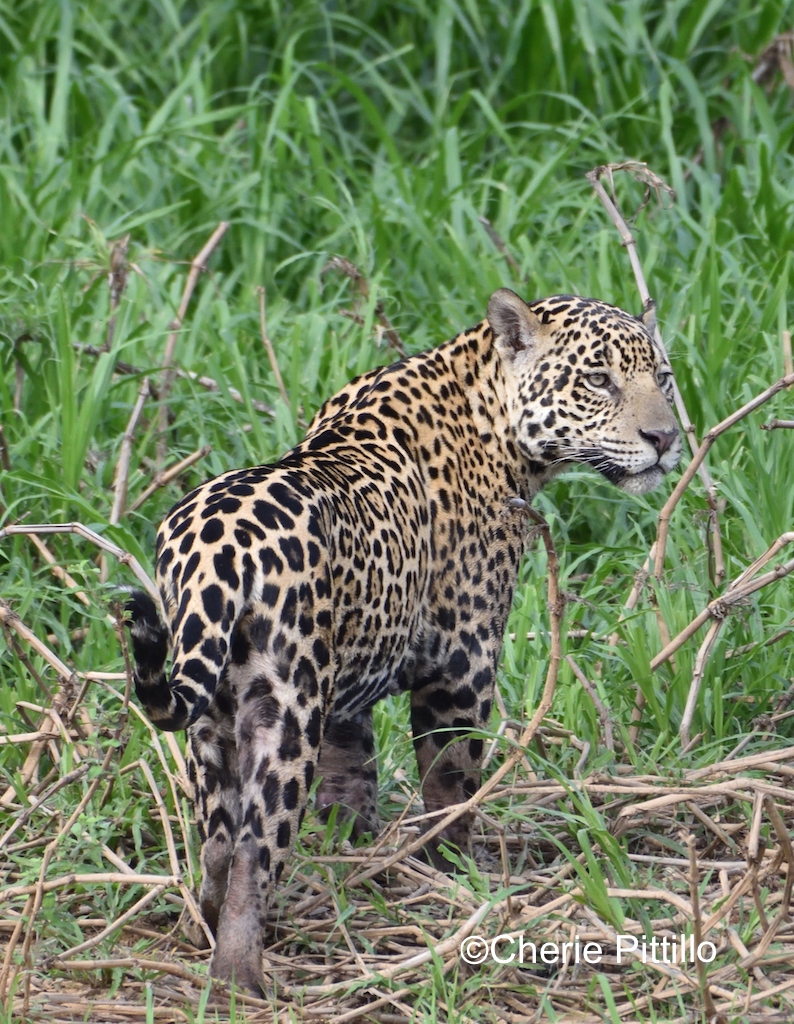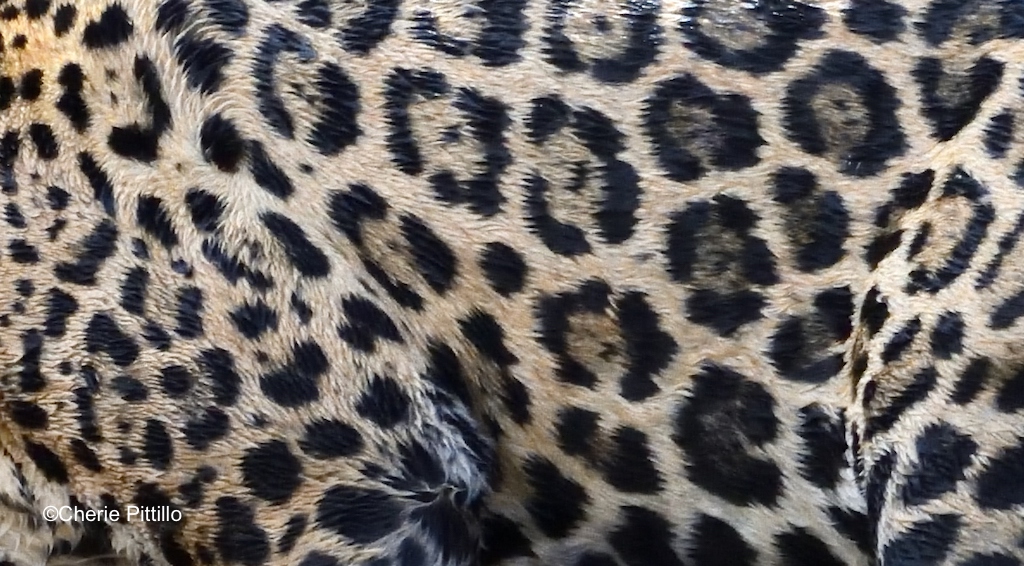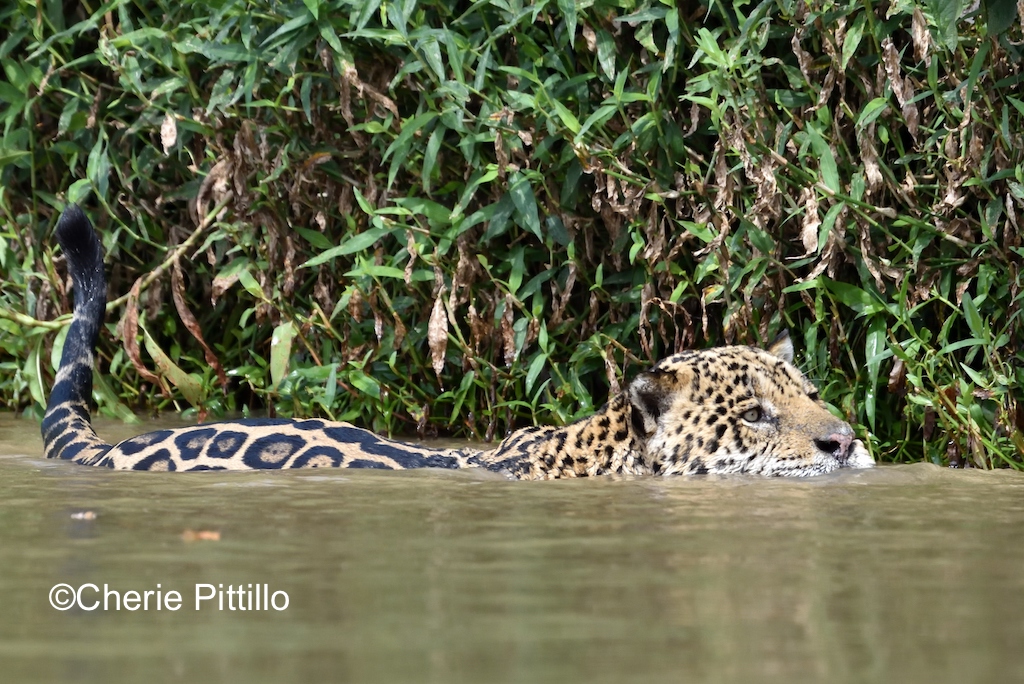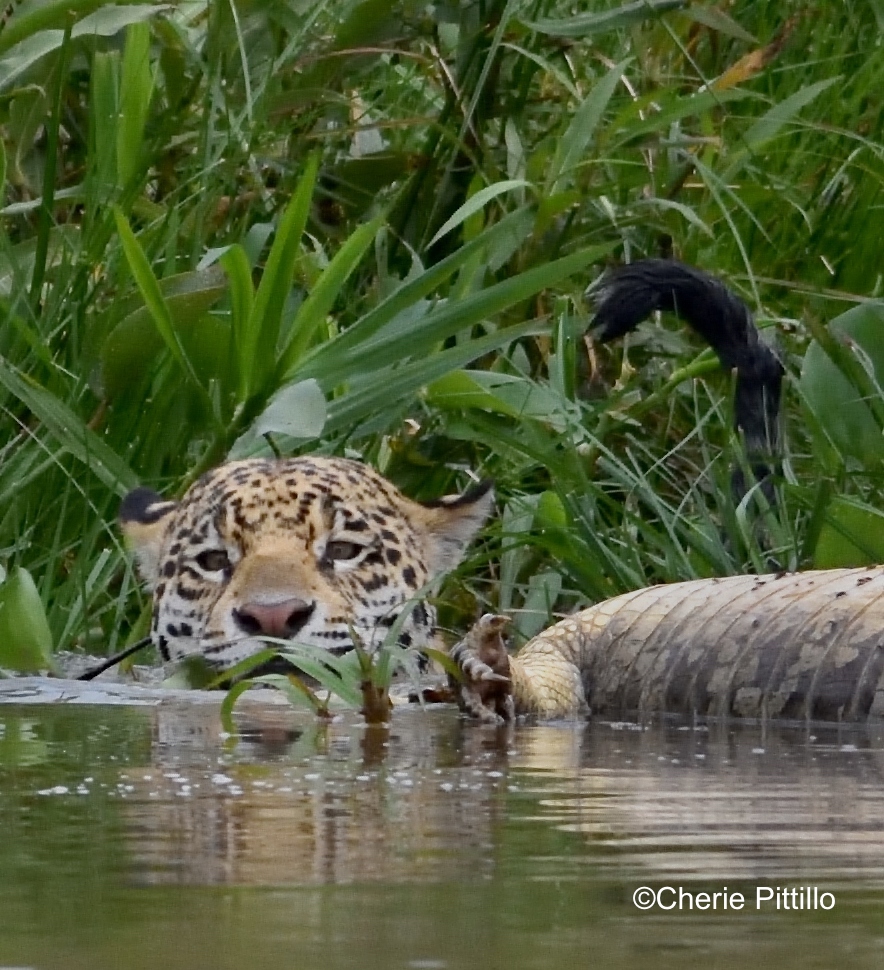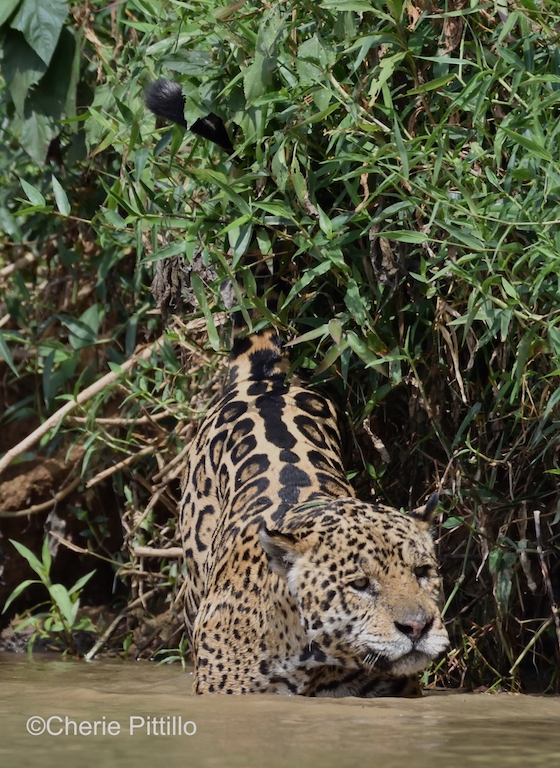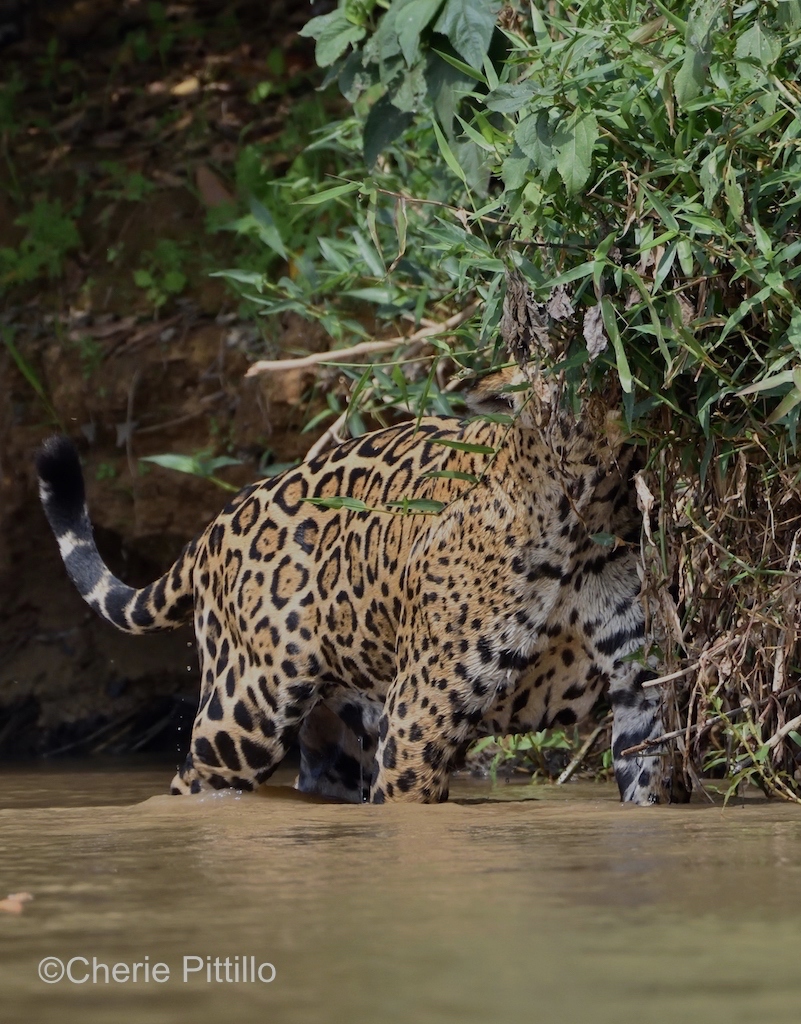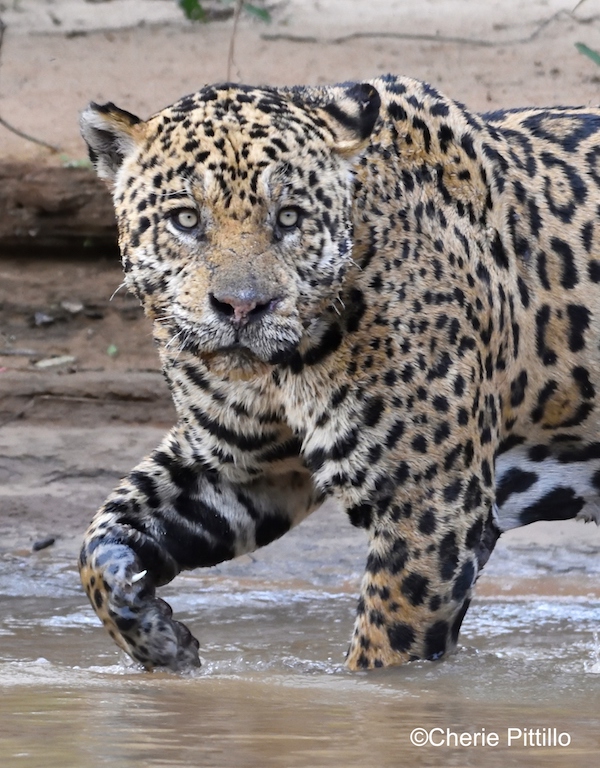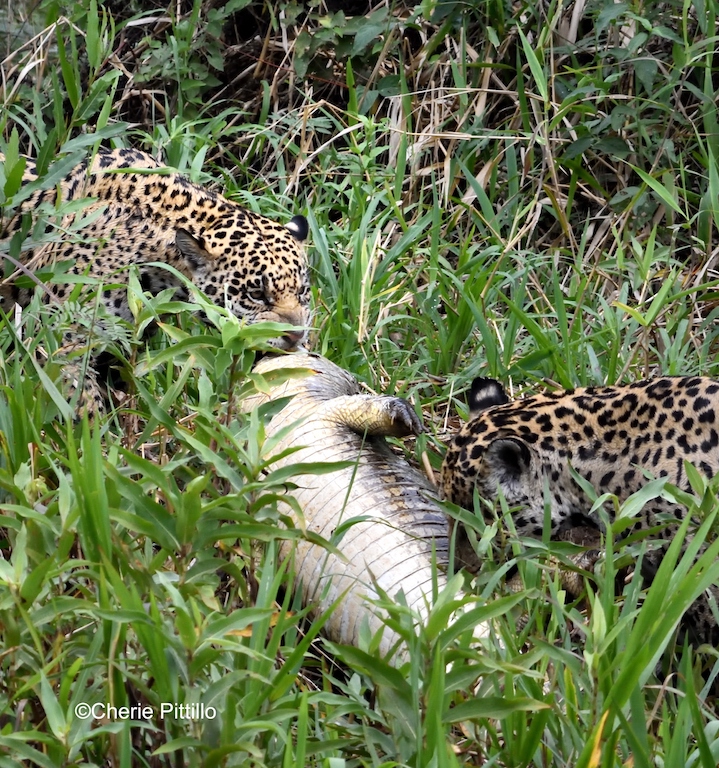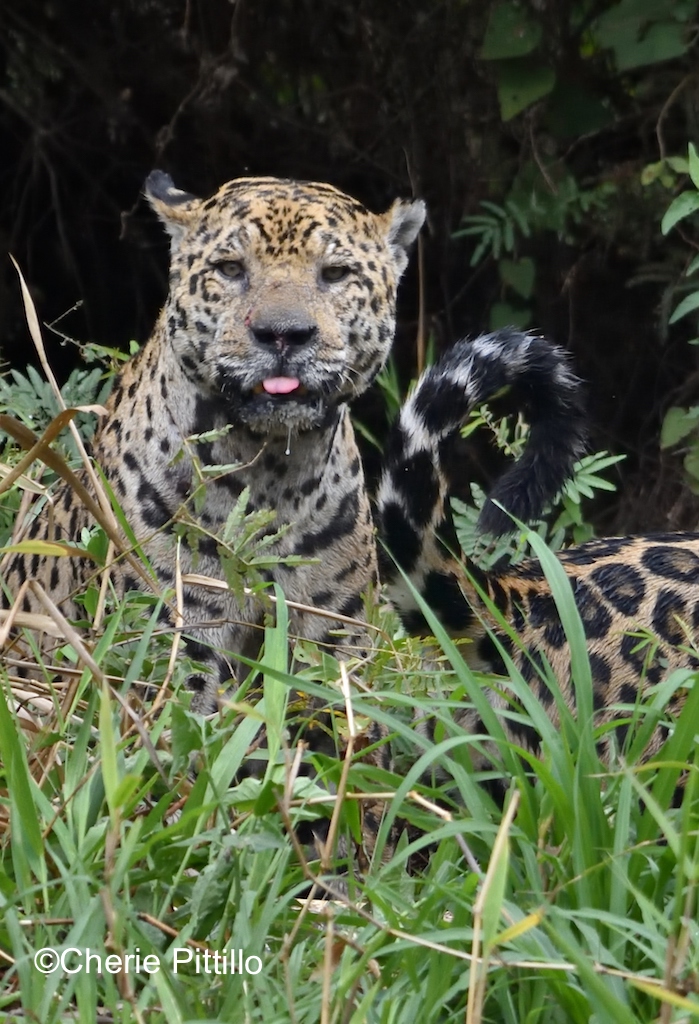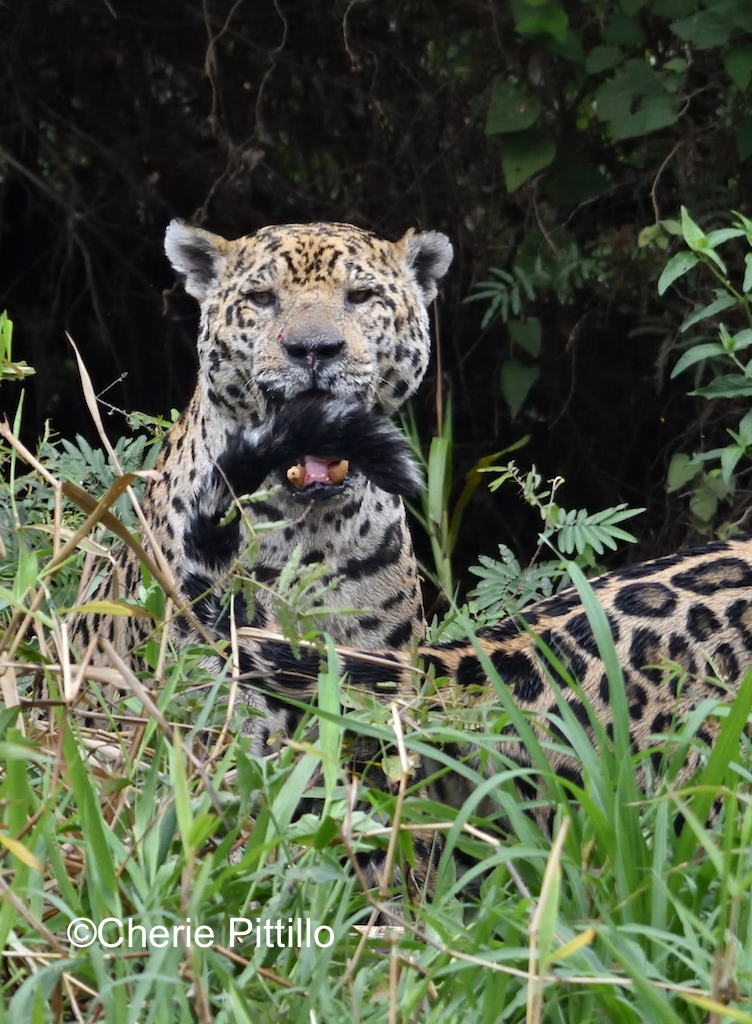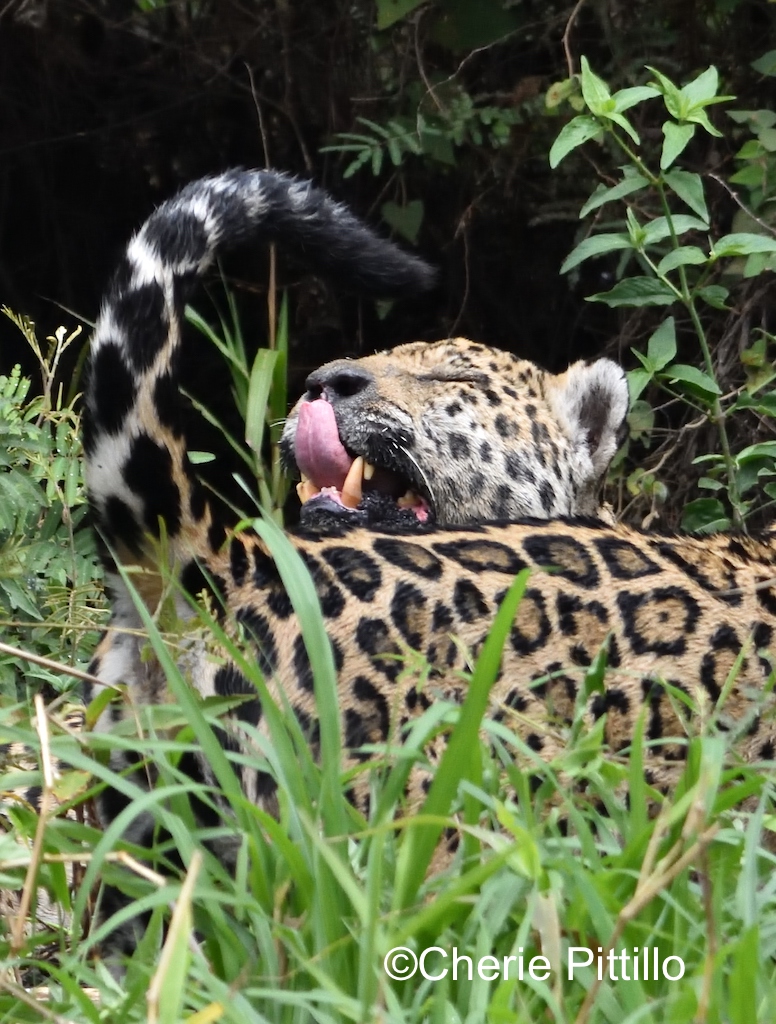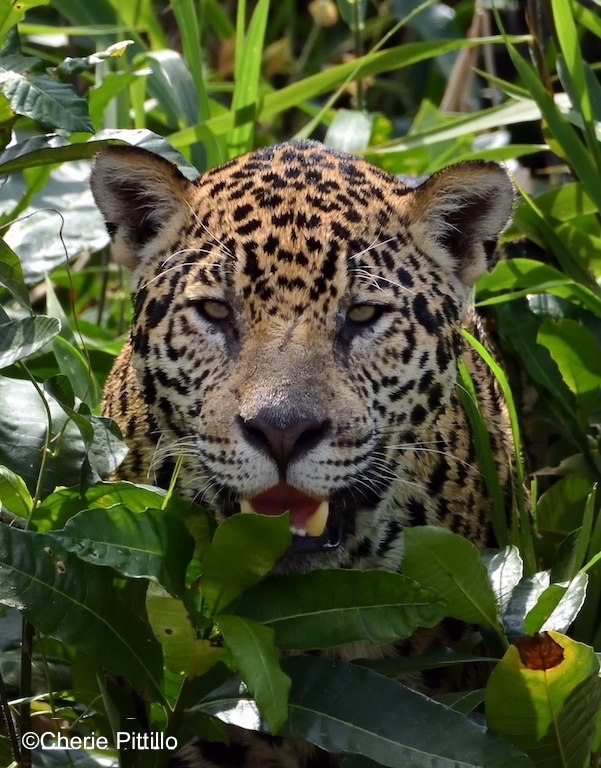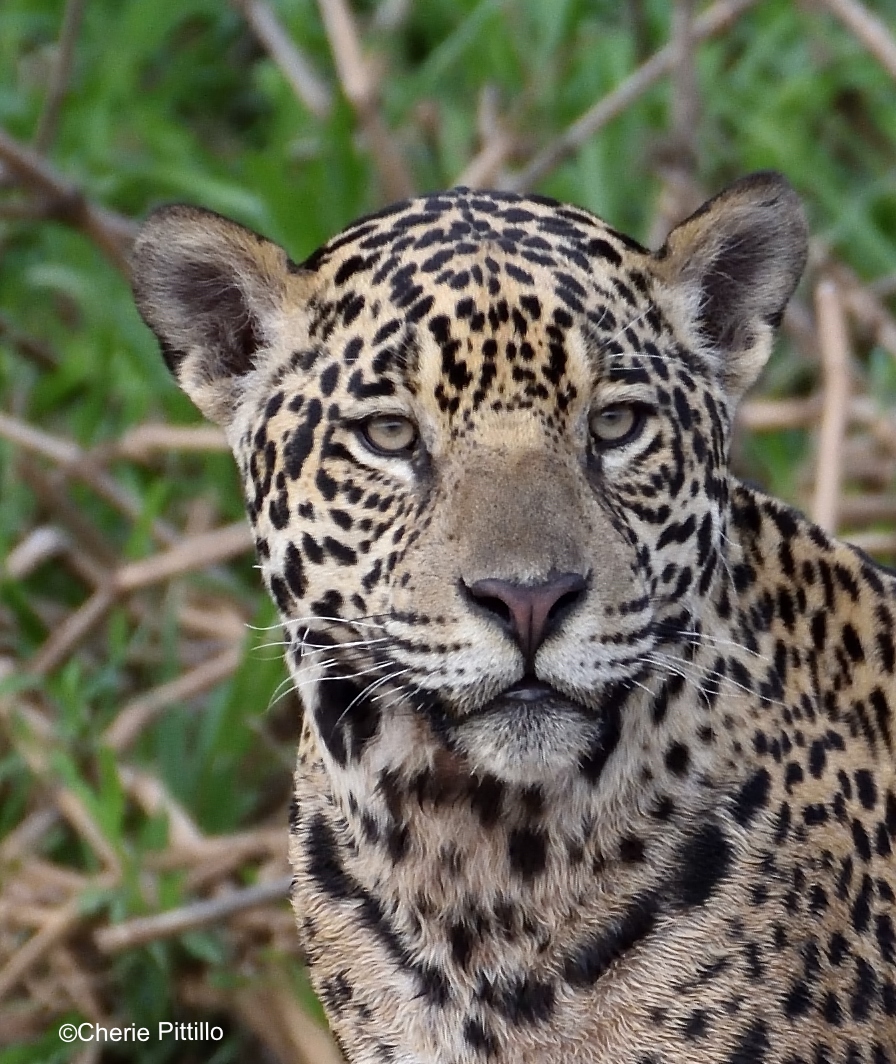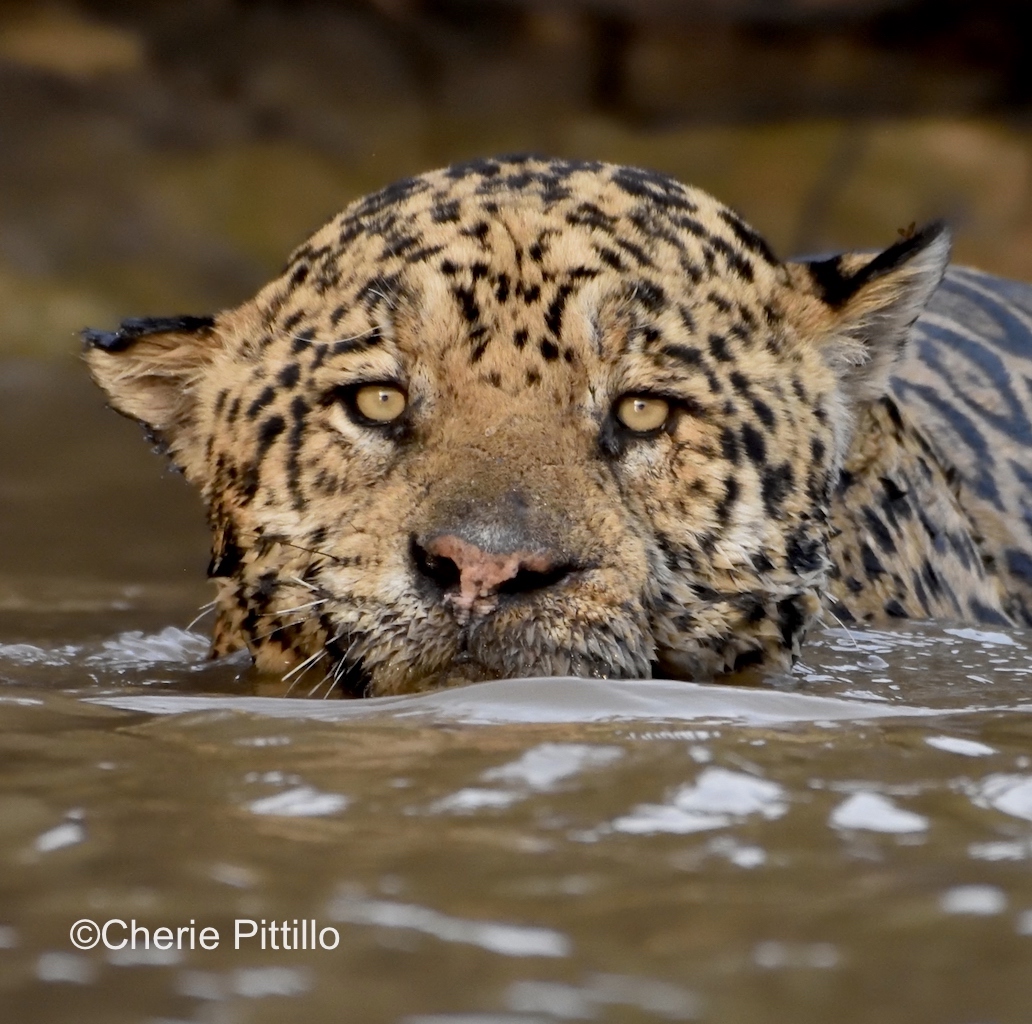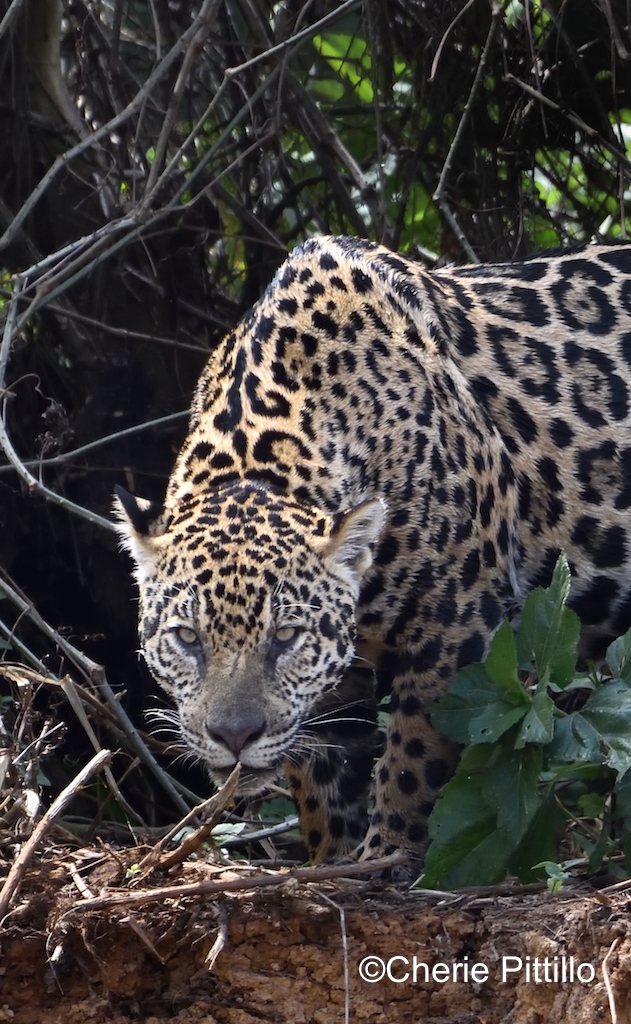Jaguar, Panthera onca, El Jaguar (Spanish), Balam (Mayan), Onça (Brazilian Portuguese)
DE-TAILS AND OTHER ACCESSORIES
After the surprise and awe of photographing my first jaguar in the Pantanal, Brazil, I tried to assimilate my observations of several jaguars during five days in a comfortable small boat.
Besides behavior, what intrigued me were details of their ‘accessories’: tails, whiskers, nose, paw pads, coat pattern, and their massiveness.
First, the tail seemed too short in proportion to the jaguar body. Sometimes a tail had been nipped off somehow, but most of the time, the jaguar seemed short-changed so to speak.
Actually, the tail consists of only 19 tail vertebrae and is 20% shorter than the other big cats of lion, tiger, and leopard. (Big cats can roar while cheetah and puma can purr instead of roar and are not considered “big cats”).
Also the jaguar tail tip is covered in black fur, but I recalled the underneath of a leopard tail is white. Why did that surprise me? I’ve worked as a zookeeper with African leopards and a Siberian tiger at the North Carolina Zoo. I’ve also lived in Africa and traveled extensively in East and southern Africa to observe lions, leopards, and cheetahs. Sometimes in my mind’s eye, I couldn’t help but compare the jaguar to an African leopard. Supposedly that white coloration helps cubs follow their leopard mother in tall grasses. I don’t know the function of that dark tail in the jaguar.
In addition the most frequent question I’m asked: “What is the difference between a jaguar and a leopard?”
“Rosettes.”
“Rose what?”
“The coat pattern in jaguars and leopards contain rosettes – black dots in a loose circle. Jaguars usually have smaller black spots within their large rosettes while leopards lack those center dots in their small rosettes. Look at these two photos:
“Of course the jaguar is larger and stockier than the leopard and lives in the Americas while leopards live in Africa and Asia.”
Continuing with the tale of tails, how fascinating to watch jaguars swim or walk in the water and how they held their tails. I’m still amazed that one jaguar walked in the river and hiked up his tail to spray urine to scent mark vegetation hanging over the river.
In reference to scent marking, jaguars have several scent glands on or near the head, ears, mouth and chin, paws, tail base, and anus. How enjoyable to watch this jaguar mark his territory by rubbing his face back and forth in bushes to leave his scent, whether he walked in the river or on land.
Even the mere act of walking marks the territory from scent glands on the paws. Plus soft, cushiony pads serve as shock absorbers when the cat runs or climbs trees. They soften the landings, aid in stalking prey silently and protect the claws. I noted how some cats had flesh colored pads while others only had dark pads. Those color differences may relate to the variation in multi-colored cats. Just one more thing to paw-nder.
I witnessed another way of scent-sual marking. In this series of photographs, the first image shows a female growling as a male approached her prey. Both helped drag the carcass onto level ground to feed on it opposite each other. But then the male stopped eating and sat on his haunches. The female came closer to him and began to waft her tail in front of him. I called it flirting. He responded by bringing those chemical signals/pheromones from her tail scent glands into his mouth to the Jacobson’s organ to test her readiness to mate. Definitely end-trigued and better loving through chemistry!
By the way, the nose has over 200 million olfactory cells compared to only five million in a human. Scientists suggest that great sense of smell may work more to protect territory and find a mate rather than to hunt prey.
Beneath the nose is a short muzzle with only 30 teeth unlike dogs or bears or many carnivores that have 42. In big cats, that shortening of the jaw offers a more powerful bite. In part 1 of Jaguar Journey, I mentioned this species has the most powerful bite of any big cat. After more research, some references state the tiger does while others contend the jaguar does. I want definitive answers but science isn’t like that. I’ll address that later.
On either side of the muzzle, the cheeks and above the eyes are three sets of whiskers (vibrissae). Those next to the lips project forward and may help in choosing a spot for the killing bite to the brain or neck. What I didn’t learn was what happens when you have few whiskers left?
Look at this female who is using her tongue to gather more details about her environment. It was easy to assume she was a male because of her size. Not only did her tail seem short, but also her legs. Actually front and hind legs of jaguars are relatively shorter compared to other big cats. And the shoulders seemed almost loose due to a vestigial collarbone that doesn’t attach the breast bone to the shoulder. Therefore the shoulders can move more freely which can increase range of motion and can lengthen stride.
Before my jaguar journey, I believed that jaguars were solitary, nocturnal animals as most references state. But new field research and first hand observations indicate otherwise. In a specific protected area of the Pantanal, jaguars may roam the same area at different times of the day with overlapping territories. That may be related to the high density of jaguars there with 10 cats/100km² rather than 2/100km² (about 25,000 acres). Camera traps recorded that up to four jaguars may feed on the same carcass at different times of the day.
This Pantanal area embraced ecotourism where jaguars were worth more alive than dead. They behave naturally in this protected area during the daytime which has brought education, awareness, and economic development to the people who live and work there. Protection brought conservation, not only for the jaguar, but for all other species. Conserve the intact habitats for a top predator, other animals and plants can thrive.
AUTHOR’S NOTE:
This trip exceeded any expectations I conjured up and was a life highlight. Our small group of eight photographers with two leaders explored in comfortable boats primarily three rivers, the Cuiaba, Three Brothers, and Negro in this southern part of the Pantanal. Through Joseph Van Os tours, I give the highest praise to both super, knowledgeable, easy-going guys: Mark Thomas, photography leader, http://www.blueiceberg.com and [email protected] and Paulo Boute, Brazil leader, https://www.boute-expeditions.com
DISCLAIMER: References do not agree on details about these species.
Panthera Onça
http://www.procarnivoros.org.br/pdfs/Azevedo_Murray_Spatial_organization_and_food_habits_%20jaguars.pdf
https://academic.oup.com/jmammal/article/91/3/722/846646/Kill-rates-and-predation-patterns-of-jaguars , http://www.arkive.org/jaguar/panthera-onca/video-12.html
http://www.askabiologist.org.uk/answers/viewtopic.php?id=3590
https://purrfectlove.net/2017/01/scent-glands-on-cats/
https://www.sciencedaily.com/releases/2016/10/161026151152.htm
https://www.wanderlust.co.uk/content/jaguar-watching-pantanal-brazil?page=all
http://www.cnn.com/travel/article/brazil-pantanal-wetlands/index.html
Cherie Pittillo, “nature inspired,” photographer and author, explores nature everywhere she goes. She’s identified 56 bird species in her Merida, Yucatan backyard view. Her monthly column features anecdotes about birding in Merida, Yucatan and also wildlife beyond the Yucatan. Contact: [email protected] All rights reserved, ©Cherie Pittillo

